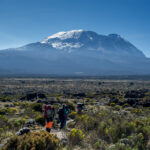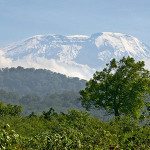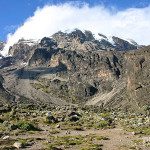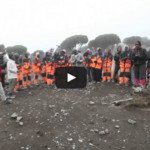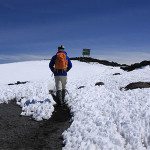 Photo: Thomson Safaris guest, Michael Fischer
Photo: Thomson Safaris guest, Michael Fischer
Any journey up Kilimanjaro is filled with a series of natural wonders, from strange, alien plant life to towering outcroppings that offer very imposing proof of Kilimanjaro’s volcanic history. The route you take up the mountain may decide which of these famous sights you’ll have a chance to see up-close, but there’s one wonder of Kilimanjaro any successful trekker can spot: the Reusch Crater.
The story of this famous depression on Africa’s highest peak is interesting both geologically and historically. Many trekkers know of Kilimanjaro’s fiery past; the three peaks—Shira, Mawenzi, and Kibo—were once all active volcanoes. Over thousands upon thousands of years, they erupted continually, building the mountain ever-higher, until one by one they went extinct: first Shira sputtered out, then Mawenzi. Kibo, ever the overachiever of the bunch, decided to keep its options more open; the tallest of Kili’s peaks is considered dormant, but not dead.
Sites like Lava Tower and the Reusch Crater are a direct result of Kili’s former volcanism. The top of Kibo isn’t like a child’s simple drawing of a mountain, tapering to a single point. Instead, Kibo is capped with a caldera, a crater formed when a volcanic mountaintop collapses due to reduced internal pressure (once the lava flow that formed the mountain recedes, the top often falls inward).
Uhuru Peak, the mountain’s official highest point, stretches upwards along one edge of this caldera, but if trekkers take a moment to look down from the top, rather than up, they’ll notice a series of interesting formations. Within the caldera is another crater, Reusch Crater, and within that lies yet another indentation, the Ash Pit. From above, the whole thing looks a little like a collapsible telescope dropping down towards Kili’s center. So why Reusch Crater? Who was Reusch, anyway?
He wasn’t the first to reach the roof of Africa (that honor goes to Hans Meyer and Ludwig Purtscheller), but he was one of the most committed. Reusch, a German missionary working in the Kilimanjaro region, first made it to the top in 1926, during which trek he was the first to ever spot the crater that now bears his name (because early trekkers each took different routes to the top, many of Kili’s most famous landmarks weren’t immediately recognized).
Then he climbed the mountain another 64 times, give or take (Reusch successfully summited 49 times, but ascended the mountain, at least in part, 65 times). He may not have won the sprint up the mountain, but no one can beat the man’s endurance. In fact the crater was named for Reusch in 1935, as part of a ceremony in which the Tanganyikan government awarded Reusch a medal—and everlasting fame—in recognition of his 25th successful summit.
But Reusch is notorious for another reason. He was the first to spot a carcass of a frozen leopard near the summit and, seasoned explorer that he was, he made certain to document it, snapping a photograph and slicing off an ear (if that seems unnecessary, it could have been worse; Reusch originally attempted to remove the head, but after failing to do so, “settled” for an ear).
The image reputedly inspired Hemingway’s well-known short story, The Snows of Kilimanjaro, securing Reusch a second boon: a (somewhat tangential) claim to literary fame.

